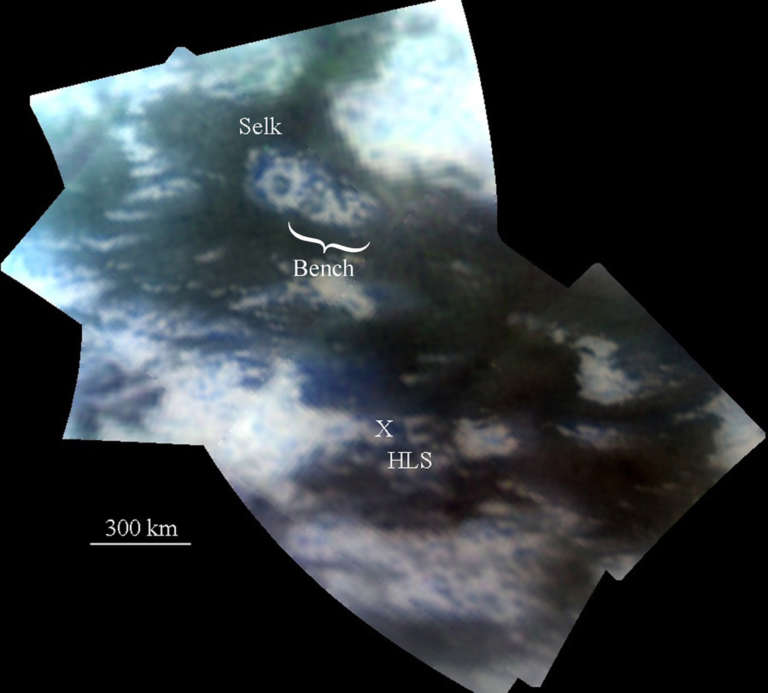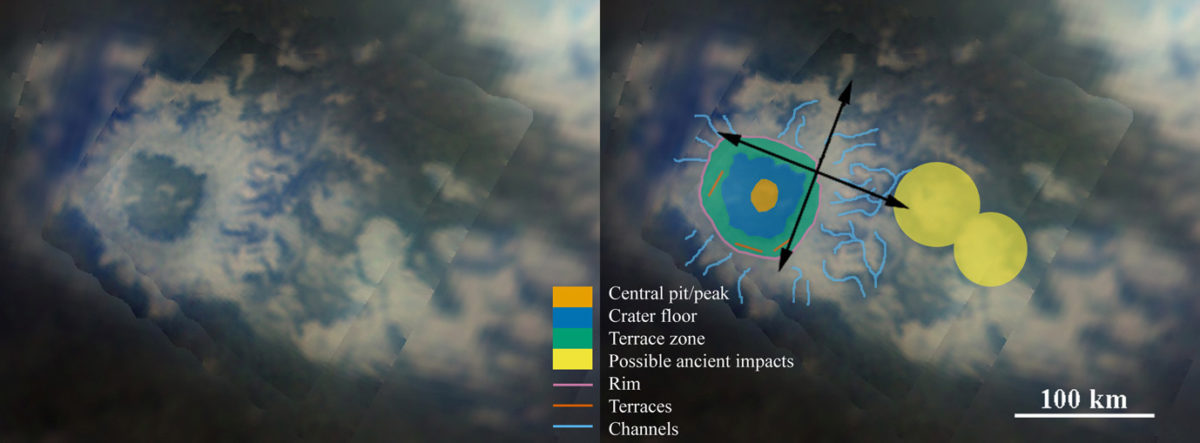Emily Martin • Aug 16, 2010
Decoding a Titan crater
Emily Martin is a former student of my former grad school officemate who is now a PhD student in the Terrestrial and Planetary Structural Geology and Geomechanics program at the University of Idaho. She is researching the fracture development on Enceladus, with an emphasis on strike-slip faults and crater-related fractures. We've been chatting by email about writing since we met at the Women in Planetary Science breakfast at the Lunar in Planetary Science Conference last March, and I'm delighted to post here her first of, I hope, several entries on outer planet science. I asked her to select some current paper in her field of study and translate it for a non-academic audience -- a writing exercise that I think would be valuable for any grad student. Anyone else out there care to give this exercise a try? Any professors want to assign this activity to your grad students? --ESL
In response to Emily's entry about finally getting her hands on a subscription to the planetary science journal Icarus, I thought I would report on an article from the most recent issue: Geology of the Selk crater region on Titan from Cassini VIMS observations, by Jason Soderblom and 11 other scientists.
Craters are some of the most useful tools planetary scientists have at their disposal. But there aren't many craters on Titan. The International Astronomical Union (IAU) has approved the naming of only 5 craters. An additional 40 or so features have been proposed to be impact craters, but the jury is still out as to their origin. Whether there are 5 or 45, the scarcity of craters implies a geologically young surface. When geologists say "young" they mean (in this case) one hundred million to one billion years old.
In this paper, Soderblom (by which I mean "Soderblom and his 11 co-authors") tries to learn what we can from one of the five named craters. He describes the formation of a crater named Selk, and how it has changed through time. This is Selk:

To begin with, they describe how Selk looks today, drawing from Visual and Infrared Mapping Spectrometer (VIMS) images. They figured out its topography by using photoclinometry -- that is, determining its shape from shading. But there is a problem with using photoclinometry across Selk: shape from shading only works well when the albedo, or brightness, is constant. Selk mostly has a dark interior and bright exterior, so they couldn't calculate topographic profiles crossing that bright-dark boundary. But they did find regions with uniform albedos on the eastern side of the crater, where they were able to calculate long profiles.
The topographic profiles they calculated made it possible to identify the eastern crater rim, which does not coincide with the boundary between light and dark; the crater's rim is actually outside the light-dark boundary. They measured the crater's diameter to be about 90 km.

The topographic profiles allowed them to map out the crater's structures. Why do these maps matter? Because the presence or absence of certain crater structures, and how large or how steep they are, can tell us a lot about the interior of a planet or moon, and the materials that it's made of, which is why I think craters are so awesome. The problem is, much of the data on Titan is pretty low resolution (around 2.5 to 4.4 kilometers per pixel), so it is often hard to see finer scale details. For example, the team could not determine if the center of the crater is a peak or a pit.
How to proceed? There is more than one large cratered icy moon in the solar system, and the rest of them don't have atmospheres that fuzz out the details. The VIMS team looked at craters on Callisto and Ganymede and compared them to Selk to learn more about Titan. Ganymede and Callisto have similar compositions and surface gravity to Titan. Soderblom measured the diameter of Selk crater's central feature and compared it to the rim diameter. The ratio of those is similar to that of comparatively sized dome craters on Callisto and Ganymede. Because the formation of craters on other icy moons is pretty well understood, we can read the craters on Titan even if we can't see them very well.
So, what can we read from Selk? Selk has a terraced wall. Similar craters on Ganymede and Callisto have narrower terraces. Soderblom and co-authors suggest that Selk's terrace could be larger because the rim has undergone more slumping than what is expected for equivalently sized craters on other moons. So, materials that were on Titan's surface when this crater formed are probably different than what is found on Ganymede and Callisto.
Also, and this is really cool, Selk crater has a geometric shape, rather than circular. That shape suggests there were planes of weakness in Titan's lithosphere before the impact. Thus, the shape of a crater -- something we can see from a distance, on the surface -- tells you something about what is going on in the subsurface!
Soderblom and his coauthors also described a feature they informally named the "bench." This origin of this bright feature to the east-southeast from Selk crater is unclear. It's large, on the order of hundreds of kilometers -- a few times larger than the crater itself. They put forth a few hypotheses for how it could have formed. Maybe Selk crater is acting as a wind shield, inhibiting the formation of dunes? Maybe the bench is a flow feature caused by impact-induced cryovolcanism? Maybe it's related to a cluster of possible impact events predating the Selk impact? Or could there have been enough heat to create a fluid-like ejecta that flowed over the surface? And that's just a sampling of the possibilities! Planetary science is exciting not only for what we discover -- but because of what we find out we don't know.
I really enjoyed this journal article. I'm always looking forward to new publications reporting on Titan and the other icy satellites. So many of these satellites have similar characteristics and processes. Still, I never know what's next! It's like a never ending story that we all get to help write in some way. I'm lucky that I get to participate every day I walk into my office! I challenge you to call it work!
If you want to stay up-to-date on the latest discoveries reported in Icarus, you can sign up for email alerts which include the tables of contents. Or you can just watch blog for the latest news!
Support our core enterprises
Your support powers our mission to explore worlds, find life, and defend Earth. You make all the difference when you make a gift. Give today!
Donate

 Explore Worlds
Explore Worlds Find Life
Find Life Defend Earth
Defend Earth

